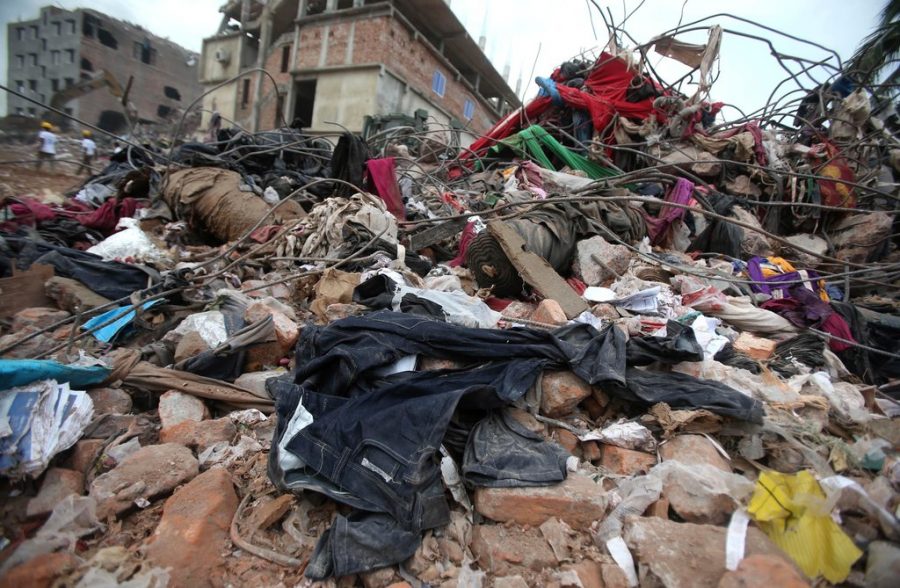Not So Fast Fashion
The immediate gratification of purchasing inexpensive, trendy clothing entails much greater hidden costs that must be paid sooner or later.
Wong Maye-E/ Associated Press, New York TImes
A majority of fast fashion clothes end up in the landfill in no time.
March 24, 2020
Splattered over social media — and often endorsed by pop culture’s favorite celebrities — are ads for “fast fashion” brands, such as ZARA and FashionNova. Straight from the catwalk to your closet — how can you resist?
Not so fast.
The appeal is certainly tempting. As fashion trends race by at an increasingly fast pace, it seems foolish to spend large amounts of money on trendy apparel, as it goes out of style almost as fast as it came into style in the first place. This is where fast fashion brands have found a market hold.
Fast fashion is a sub-industry focused on selling inexpensive clothing, produced especially quickly in response to fashion trends. However, behind the cheap price is an especially high cost to the planet.
The fashion industry is currently the second most polluting industry, only behind oil. The rapid pace at which clothing clothing is produced means that the same clothing is being thrown away equally quickly. Due to the use of cheap fabrics, such as polyester, many consumers simply toss the garments away when they tear only to buy more of the cheap clothing. Thus, the cycle continues.
Some online fast fashion brands feature up to 200 new items a week, which sounds like a lot until customer demand is considered. Customers bought over 60% more clothing in 2014 than in 2000, and they kept their clothes for only half as long.
The environmental toll is considerable. Over half of the fibers in fast fashion clothing are synthetics that come from fossil fuels — thus, when those shirts and pants end up in the landfills, they will not decay anytime soon. Alarmingly, 85% of the U.S’s textile waste goes to landfills.
In the U.S., 13 trillion tons of clothing are sent to landfills, equivalent to a football field with piles of clothes 14 feet tall, which then sit there for 200 years and contaminate soil and water with toxic dyes and chemicals.
Additionally, CO2 emissions from the fast fashion are increasing yearly and leaving behind detrimental impacts on the planet. 10% of global carbon emissions come from fashion, and the number is expected to only continue increasing. The CO2 emissions are projected to increase by 60% by only 2030, putting the level at 2.8 billion tons in just one year.
The fast fashion industry also impacts the earth’s water. It’s the second-largest consumer of the earth’s water supply. Countries like China and India that have heavy cotton-producing economies are facing severe water issues, and by 2030, global water consumption is expected to go up by at least 50%. Those countries with profitable fashion industries are then forced to make the decision between either having clean water supplies or continuing to support their cotton economies with reliable source of revenue.
It’s not just the water supply that is harmed. The oceans are also facing the consequences of cheap and quick clothing production. The remains of discarded clothing items are often found in the ocean, harming aquatic life and straining the seafood industry. A report from the IUCN found that 35% of microplastics found in the ocean, which are incapable of biodegrading, are sourced from synthetic fabrics like polyester.
Cheap fashion exacts a horrible human toll, as well. The majority of workers in the industry are young girls, who face harmful work conditions daily, often earn less than merely $3 a day . They inhale harmful substances, such as chemicals and sawdust, which can cause diseases, and they also face sexual harassment on the job.
It’s practically beyond debate that the fast fashion industry is harmful for both humans and the environment, though they appeal shows no signs of letting up. However, there are alternatives that provide the same advantages with much less harm.
Thrifting is an excellent, environmentally friendly way to get new clothes, with stores like Plato’s Closet offering trendy second-hand clothes and your local Goodwill offering the best prices around in exchange for lowering your expectations a bit.
Additionally, many brands, such as Patagonia and Nike, are beginning to switch to green practices. These are the companies that deserve our dollars. The UN even launched the Alliance for Sustainable Fashion, in an effort to promote the cause.
In the end, fast is not always favorable. ZARA and FashionNova may save you some money in the short term, but the hidden costs must be paid down the line.












